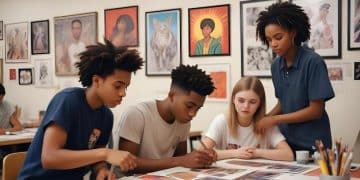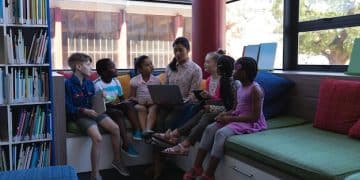Are VAK Learning Styles Still Relevant in 2025? Expert Insights

The Visual-Auditory-Kinesthetic (VAK) learning styles model, while historically influential, faces increasing scrutiny in 2025 regarding its scientific validity and practical relevance in modern educational paradigms, with many experts advocating for more dynamic, evidence-based approaches to learning.
The concept of The Visual-Auditory-Kinesthetic (VAK) Learning Styles has long been a cornerstone in educational discussions, suggesting that individuals learn best when information is presented in ways that align with their preferred sensory input. For decades, educators and parents alike have explored these styles—Visual, Auditory, and Kinesthetic—hoping to unlock more effective learning strategies. Yet, as we navigate the complexities of 2025, a critical question emerges: Do VAK learning styles still hold meaningful relevance in contemporary education, or have advancements in cognitive science and pedagogical research rendered them obsolete?
Understanding the Core of VAK Learning Styles
The VAK model categorizes learners into three primary types based on their dominant sensory preference for receiving and processing information. Visual learners supposedly grasp concepts best by seeing them, auditory learners by hearing them, and kinesthetic learners by doing or experiencing them. This framework became popular for its intuitive appeal, offering a seemingly straightforward path to personalize education and improve learning outcomes. However, a deeper dive reveals that its foundations, while widely adopted, have always been subject to academic debate.
Proponents of the VAK model frequently advocate for tailored instruction. For instance, a visual learner might benefit from diagrams, charts, and written notes, an auditory learner from lectures, discussions, and audio recordings, and a kinesthetic learner from hands-on activities, role-playing, and movement. The belief was that by aligning teaching methods with a student’s dominant VAK style, educators could significantly enhance comprehension and retention, making learning more efficient and engaging. This personalization seemed a revolutionary step forward in education.
The journey of VAK from an informal observation to a widely-used educational tool is quite interesting. Originally rooted in neuro-linguistic programming (NLP) in the 1970s, it gained traction through popular psychology books and educational workshops. Its simplicity made it accessible, and the idea of “unlocking” a student’s potential by matching their learning style resonated strongly with both teachers seeking effective strategies and parents eager to support their children’s academic success. This widespread acceptance led to its inclusion in teacher training programs and educational policy discussions across various countries.
However, despite its pervasive influence, the scientific community has consistently struggled to find robust empirical evidence to support the efficacy of VAK learning styles. While individual preferences for how information is delivered certainly exist, the idea that tailoring instruction to these preferences significantly improves learning outcomes has largely been disproven by rigorous research. This gap between popular belief and scientific validation forms the crux of the debate surrounding VAK’s relevance today. It highlights the challenge of distinguishing between intuitive models and those supported by empirical data in the dynamic field of education.
The Historical Context and Rise of VAK’s Popularity
The VAK model, or variations of it, isn’t a new concept; its roots can be traced back to earlier notions of sensory preferences in learning, emerging more formally in the latter half of the 20th century. Its simplicity was its strength, providing educators with an easily understandable framework to categorize students and, ostensibly, improve their learning experiences. The idea that understanding how someone “prefers to learn” could directly lead to better academic performance was incredibly appealing, leading to its rapid adoption in classrooms and professional development programs worldwide.
During the 1980s and 1990s, as educational psychology began to focus more on individual differences, VAK found its niche. Textbooks, teacher training manuals, and even parenting guides began to incorporate the VAK framework as a fundamental principle. This widespread dissemination cemented its place in the public consciousness. Many educators genuinely believed they were empowering students by identifying their learning styles and curating content accordingly. The anecdotes of success, though not scientifically validated, fueled its continued popularity, creating a self-reinforcing cycle of belief and practice.
Early Influence in Educational Practices
- Curriculum Design: Many curricula were designed to incorporate multi-modal approaches, implicitly supporting the VAK idea by offering various ways for students to engage with material.
- Teacher Training: New teachers were often introduced to VAK as a basic tool for classroom differentiation, shaping their pedagogical approaches from the outset.
- Parental Involvement: Parents were encouraged to identify their children’s learning styles to support homework and extracurricular learning effectively at home.
The persuasive narrative of personalized learning, even before the advent of sophisticated educational technologies, made VAK seem like a breakthrough. It offered a tangible way for educators to feel they were addressing the unique needs of each student, moving away from a one-size-fits-all approach. This focus on the individual learner, even if based on an unproven theory, marked a significant shift in educational philosophy, highlighting the growing desire for more student-centered methods. It also spoke to a broader cultural trend of individual self-discovery and optimization.
Despite its growing popularity, the scientific community remained cautious. While the concept of sensory preferences was undeniable, the leap to “learning styles” that dictated optimal instructional methods lacked empirical backing. This growing schism between educational practice and scientific research would eventually lead to a re-evaluation of VAK’s role, particularly as more rigorous studies began to challenge its core assumptions. This historical context is crucial for understanding why we are asking about its relevance in 2025.

The Academic Counter-Argument: Research and Criticism
Despite its widespread acceptance, academic research has consistently failed to provide empirical support for the VAK learning styles model. Numerous studies, including meta-analyses, have investigated the “meshing hypothesis”—the idea that instruction specifically tailored to an individual’s learning style results in improved learning outcomes. The conclusion from these rigorous investigations has been overwhelmingly consistent: there is no credible evidence to suggest that matching teaching styles to VAK learning styles enhances learning.
One of the most significant criticisms comes from cognitive psychology. Researchers argue that while individuals may have preferences for how they receive information, these preferences do not equate to enhanced learning when instruction aligns with them. In fact, most learning tasks benefit from multimodal input. For instance, understanding a complex concept often requires seeing visual representations, hearing explanations, and engaging in hands-on application, regardless of a learner’s perceived dominant style. Restricting instruction to a single modality might even hinder learning for all, rather than helping a select few.
Key Criticisms Summarized by Research:
- Lack of Empirical Evidence: Extensive research has found no scientific basis to support the VAK model’s effectiveness.
- The “Meshing Hypothesis” Debunked: The central premise that matching instruction to learning styles improves outcomes has been widely disproven.
- Oversimplification of Learning: Human cognition is far too complex to be categorized into just three distinct and unchanging styles.
- Potential for Harm: Labeling learners can create self-fulfilling prophecies or limit students’ exposure to diverse learning strategies needed for a complex world.
Furthermore, critical examinations have highlighted the inherent flaws in the methodology often used by VAK proponents. Self-assessment questionnaires, which are frequently used to identify a learner’s VAK style, are often found to be unreliable and lack validity. What a person *thinks* is their preferred learning style does not necessarily reflect how they *actually* learn most effectively. This discrepancy underscores the danger of relying on subjective self-reporting for educational interventions.
Another point of contention is the notion that individuals primarily use one dominant style. Cognitive science suggests that humans generally employ a diverse range of strategies and sensory inputs when learning. Restricting a student to a single “style” could potentially limit their development of critical skills in other areas. For example, an auditory learner might miss out on developing strong visual literacy if they are rarely exposed to visual information. This body of research paints a compelling picture that moves beyond simple preferences to argue for a more nuanced and evidence-based approach to teaching and learning in 2025.
The Modern Educational Landscape: Beyond VAK in 2025
As we advance into 2025, the educational landscape is increasingly shaped by advancements in cognitive science, neuroscience, and educational technology. This modern paradigm emphasizes adaptability, critical thinking, and the development of versatile learning strategies rather than adherence to rigid learning styles. The focus has shifted from identifying a static “style” to fostering dynamic learning skills that equip students for an ever-changing world. This means embracing methods that benefit all learners, regardless of traditional categorical distinctions, by incorporating multiple modalities naturally.
Contemporary pedagogy advocates for an approach known as “universal design for learning” (UDL), which seeks to create flexible learning environments that accommodate diverse learner needs without categorizing students into restrictive boxes. UDL principles promote providing multiple means of representation (how information is presented), multiple means of action and expression (how students demonstrate learning), and multiple means of engagement (how students are motivated). This comprehensive framework acknowledges that all students benefit from varied approaches, rather than a one-size-fits-all “matching” based on VAK.
Emerging Trends in Learning:
- Personalized Learning Pathways: Utilizing AI and data analytics to adapt content and pace to individual student progress, rather than fixed learning styles.
- Project-Based Learning: Engaging students in hands-on, long-term projects that integrate multiple subjects and foster problem-solving skills.
- Adaptive Technologies: Educational software that adjusts its difficulty and presentation based on student performance, providing real-time feedback and support.
- Emphasis on Metacognition: Teaching students how to learn, to monitor their own understanding, and to adapt their study strategies.
The increasing integration of artificial intelligence (AI) and machine learning in educational platforms further underscores this shift. AI-driven systems can analyze individual learning patterns, identify areas of struggle, and recommend resources that are genuinely effective, regardless of a predefined learning style. This data-driven personalization moves beyond subjective preferences to objective performance, representing a far more sophisticated and effective approach to individualizing education. The goal is to support every learner in cultivating a broad repertoire of learning strategies, not to pigeonhole them into one category.
In 2025, the discussion is less about which learning style a student possesses and more about which instructional methods are most effective for particular content, skill sets, and cognitive processes. This means educators are encouraged to be versatile, employing a rich array of teaching strategies that incorporate visual, auditory, and kinesthetic elements for everyone, rather than only for those labeled with a specific style. This holistic view prepares students not just for immediate academic success, but for lifelong learning and adaptation in a complex world.
Practical Implications for Educators and Learners in 2025
Given the prevailing academic skepticism, the practical advice for educators and learners in 2025 diverges significantly from the traditional VAK-centric approach. Instead of spending time and resources on identifying and catering to specific VAK learning styles, the focus should shift towards employing evidence-based pedagogical strategies that benefit all students and promote versatile learning. This means fostering environments where students are exposed to and encouraged to utilize various modes of engagement, thereby enhancing their cognitive flexibility.
For educators, this entails designing lessons that inherently incorporate multisensory experiences for everyone. This could mean using visual aids, incorporating discussions and verbal explanations, and providing opportunities for hands-on activities within the same lesson. The goal is not to match a single style but to enrich the learning experience for all by engaging multiple pathways to comprehension. This approach aligns with cognitive science research that suggests information processed through various sensory channels tends to be remembered more effectively and comprehensively.
Learners, too, can benefit from a more flexible mindset. Instead of believing they can only learn in one specific way, they should be encouraged to experiment with different study techniques. This might include creating mind maps (visual), explaining concepts aloud to a peer (auditory), or building models to understand complex systems (kinesthetic). The development of metacognitive skills—the ability to understand and regulate one’s own learning—becomes paramount. Students who can assess their own understanding and adapt their strategies are better equipped for academic success and lifelong learning.
Furthermore, the integration of technology in 2025 provides unprecedented opportunities for this multi-modal approach. Interactive simulations, virtual reality environments, and adaptive learning platforms can deliver content that is inherently visual, auditory, and kinesthetic, often simultaneously. These tools allow for personalized learning not by matching a static style, but by dynamically adjusting content and challenges based on individual performance and engagement, ensuring a rich and responsive learning experience for everyone in the classroom, regardless of their perceived dominant style.
Addressing Misconceptions and Moving Forward
One of the enduring misconceptions surrounding learning styles is the idea that they are fixed, immutable traits. Many still believe that if they are an “auditory learner,” they are inherently less capable of learning visually or kinesthetically. This belief can be detrimental, potentially leading individuals to limit their own learning strategies and avoid methods they deem outside their preferred style. In 2025, it’s crucial to dismantle this myth and emphasize that effective learners are those who can adapt their approach based on the task at hand, leveraging multiple cognitive tools.
The transition away from VAK doesn’t mean abandoning the idea of individual differences in learning; rather, it suggests a more sophisticated understanding. While people do have preferences and strengths, these are not rigid categories that dictate how they can or cannot learn. Instead, effective teaching and learning involve recognizing these preferences as starting points for engagement, while simultaneously encouraging the development of a broader range of skills. For instance, a student who prefers visual input might still benefit greatly from explaining a concept verbally, as this actively engages a different part of their cognitive process, reinforcing understanding.

Moving forward, educators should prioritize teaching strategies that are universally beneficial and supported by cognitive science. This includes techniques like spaced repetition, retrieval practice, active recall, and interleaved practice. These methods have strong empirical backing for improving retention and comprehension across diverse learners, irrespective of their perceived VAK style. The focus shifts from diagnosing a “style” to implementing proven pedagogical methods that foster deeper learning and skill acquisition for all students.
Ultimately, the goal in 2025 is to cultivate resilient and adaptable learners. By understanding that strong learning involves engaging multiple senses and cognitive pathways, we can empower students to become strategic thinkers who approach challenges with a versatile toolkit of techniques. Dismissing the VAK model isn’t about dismissing personalized education; it’s about refining our approach to ensure it’s grounded in evidence, promoting true cognitive growth, and preparing students for a world that demands continuous adaptation and learning.
The Future of Personalized Learning and Cognitive Science
As we navigate further into the 21st century, the conversation around personalized learning is becoming increasingly nuanced and sophisticated, largely informed by advances in cognitive science and neuroeducation. In 2025, true personalized learning transcends the simplistic categorization of VAK styles. Instead, it leverages data, artificial intelligence, and a deeper understanding of brain plasticity to tailor educational experiences that are genuinely responsive to individual learners’ evolving needs, not just their fixed preferences. This represents a paradigm shift from broad categories to dynamic, granular insights about how each student learns best.
Cognitive science continues to unravel the complexities of memory, attention, and problem-solving, revealing that the brain is a highly adaptable organ. This understanding challenges the static nature of VAK styles, suggesting that effective learning involves a flexible interplay of various cognitive processes and sensory inputs. Researchers are exploring how factors like working memory capacity, executive functions, and prior knowledge interact to shape individual learning pathways. These insights lead to interventions that are far more targeted and effective than simply presenting information visually, audibly, or kinesthetically.
The role of technology in this future vision is also pivotal. Adaptive learning platforms, already a significant part of the educational landscape, are becoming even more intelligent. These platforms can track student engagement, performance patterns, and even emotional responses to customize content, feedback, and pace in real-time. This level of personalization is far more intricate than what VAK could ever offer, adjusting to a student’s current understanding and cognitive load, rather than a broad, predetermined category of learning. It means learning experiences can be truly optimized moment-to-moment.
Furthermore, the emphasis is shifting towards teaching students how to understand their own learning processes—metacognition. Empowering learners to reflect on their strengths, identify areas for improvement, and strategically choose appropriate learning methods is seen as more beneficial than assigning a fixed style. This self-awareness, coupled with exposure to diverse instructional techniques and technology-enhanced learning environments, prepares students to be lifelong learners who can adapt to any new challenge. The future of personalized learning in 2025 is about fostering dynamic learners, not labeling static styles.
Conclusion: Moving Beyond the VAK Model in 2025
In conclusion, while The Visual-Auditory-Kinesthetic (VAK) Learning Styles model has profoundly influenced educational thought for decades, its relevance in 2025 is increasingly questionable. The scientific community has largely debunked the core premise that tailoring instruction to an individual’s self-identified learning style leads to improved outcomes. The notion of fixed learning styles has been superseded by a more nuanced understanding of human cognition, which emphasizes adaptability, metacognition, and the benefits of multimodal instruction for all learners.
For educators and learners alike, the shift in focus should be towards embracing evidence-based practices that foster versatile learning skills. This means designing lessons that inherently integrate diverse sensory inputs, encouraging students to experiment with various study techniques, and leveraging adaptive technologies that personalize learning based on genuine progress, rather than perceived preferences. While individual preferences for how information is presented certainly exist, they should not be confused with rigid learning styles that dictate instructional methods.
As we continue to advance in our understanding of how people learn best, the educational landscape of 2025 prioritizes dynamic, responsive approaches over static categorizations. Moving beyond the VAK model allows us to create more inclusive, effective, and truly personalized learning environments where all students are empowered to develop a robust toolkit of learning strategies, preparing them not just for academic success, but for a lifetime of adaptive learning in a rapidly evolving world.
| Key Point | Brief Description |
|---|---|
| 📚 VAK’s Foundational Appeal | Offers an intuitive, straightforward framework for categorizing learners as Visual, Auditory, or Kinesthetic. |
| 🔬 Academic Scrutiny | Rigorous research consistently finds no empirical evidence supporting the “meshing hypothesis” of VAK. |
| 💡 Modern Pedagogy | Emphasizes universal design for learning (UDL) and multi-modal instruction, benefiting all students. |
| 🚀 Future of Learning | Leverages AI, cognitive science, and metacognition for dynamic, personalized learning experiences. |
Frequently Asked Questions About VAK Learning Styles in 2025
Extensive academic research, particularly in cognitive psychology, has consistently found no scientific evidence to support the claim that tailoring instruction to VAK learning styles significantly improves learning outcomes. While individuals may have preferences, these do not equate to enhanced learning when matched with a specific teaching method.
The VAK model gained immense popularity due to its intuitive appeal and simplicity. It offered educators an easily understandable framework to categorize students and the promise of personalized learning. This perceived ability to “unlock” a student’s potential resonated deeply with both teachers and parents, even without strong empirical validation.
Modern education emphasizes evidence-based practices like Universal Design for Learning (UDL), which provides multiple means of engagement, representation, and expression. Approaches that focus on critical thinking, metacognition, multi-modal instruction, and adaptive technologies are considered more effective for all learners in 2025.
Educators should acknowledge student preferences as potential starting points for engagement, but not as fixed learning styles that dictate instruction. Rather than matching a single style, the goal is to expose students to various effective strategies and help them develop a flexible toolkit of learning approaches for different tasks and content.
Technology, particularly AI-driven adaptive learning platforms, offers nuanced personalization that goes far beyond VAK. These tools can analyze real-time performance and adjust content, pace, and challenge levels dynamically, fostering genuinely effective and responsive learning experiences for individual students based on objective data.
Conclusion
As we advance into 2025, the educational discourse has significantly evolved beyond the classic VAK learning styles model. While VAK offered a simple framework that resonated well with many educators and parents, contemporary cognitive science and rigorous research have largely invalidated its core premise. The idea that tailoring instruction to an individual’s dominant visual, auditory, or kinesthetic preference significantly improves learning outcomes lacks empirical support, leading to a critical re-evaluation of its relevance.
Instead, the modern educational landscape champions a more dynamic and evidence-based approach. The focus has shifted from categorizing learners into fixed styles to fostering versatile cognitive skills and promoting Universal Design for Learning (UDL), which benefits all students through multi-modal and flexible instruction. Tools like adaptive learning technologies, informed by artificial intelligence and a deeper understanding of metacognition, are now at the forefront of personalized learning. These innovations move beyond simple preferences to genuinely respond to a learner’s evolving needs, fostering adaptability and a comprehensive skill set.
Therefore, in 2025, while acknowledging individual differences and preferences remains important, rigidly adhering to the VAK model risks hindering rather than enhancing learning. The future of education lies in empowering students to be strategic, adaptable learners who can effectively utilize diverse methods to engage with complex information, preparing them for a world that constantly demands new knowledge and skills.





